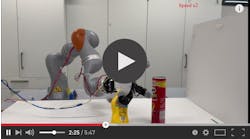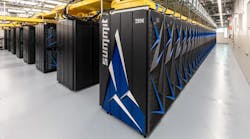The U.S. Department of Energy’s Oak Ridge National Laboratory recently unveiled its Summit computer as the world’s most powerful and smartest scientific supercomputer. It has a peak performance of 200,000 trillion calculations per second, or 200 petaflops, making it eight times more powerful than ORNL’s previous top-ranked machine, Titan. For certain scientific applications, Summit will execute more than three billion billion mixed precision calculations per second, or 3.3 exaops. It is hoped that Summit will provide unprecedented computing power for research into energy, advanced materials, and artificial intelligence (AI), among other domains, enabling scientific discoveries that were previously impractical or impossible. It also moves the U.S. closer to the DOE’s goal of having an exascale supercomputing system by 2021.
Summit is an IBM AC922, which consists of 4,608 compute servers—each containing two 22-core IBM Power9 processors and six NVIDIA Tesla V100 graphics processing unit accelerators, interconnected with dual-rail Mellanox EDR 100Gb/s InfiniBand. It has more than 10 petabytes of memory paired with fast, high-bandwidth paths for efficiently moving data. The combination of cutting-edge hardware and data subsystems marks an evolution of the hybrid CPU–GPU architecture successfully pioneered by ORNL’s 27-petaflops Titan in 2012.
ORNL researchers have also figured out how to harness the power and intelligence of Summit’s state-of-the-art architecture to successfully run the world’s first exascale scientific calculation. A team of scientists led by ORNL’s Dan Jacobson and Wayne Joubert has used the machine to run a 1.88 exaops comparative genomics calculation relevant to research in bioenergy and human health. The mixed precision exaops calculation produced identical results to more time-consuming 64-bit calculations previously run on Titan.
“From its genesis 75 years ago, ORNL has a history and culture of solving large and difficult problems with national scope and impact,” says ORNL Director Thomas Zacharia. “ORNL scientists were among the first teams to achieve gigaflop calculations in 1988, the first teraflop calculations in 1998, the first petaflop calculations in 2008, and now the first exaop calculations in 2018.
“The pioneering research of ORNL scientists and engineers has played a pivotal role in our nation’s history and continues to shape our future,” Zacharia continues. “We look forward to welcoming the scientific user community to Summit as we pursue another 75 years of leadership in science.”
Summit will be open to select projects this year while ORNL and IBM work through the acceptance process for the machine. In 2019, research teams selected through DOE’s Innovative and Novel Computational Impact on Theory and Experiment, or INCITE, program, will be lucky enough to use most of the computer’s time
In anticipation of Summit’s launch, researchers have been preparing applications for its next-generation architecture. Here are some of the areas it will be exploring:
Astrophysics. Exploding stars, known as supernovas, supply researchers with clues related to how heavy elements—including the gold in jewelry and iron in blood—seeded the universe. Highly scalable FLASH code models this process at several scales, from the nuclear level to the large-scale hydrodynamics of a star’s final moments. On Summit, FLASH will go much further than previously possible, simulating supernova scenarios several thousand times longer and tracking about 12 times more elements than past projects.
“It’s at least a hundred times more computation than we’ve been able to do on earlier machines,” says ORNL computational astrophysicist Bronson Messer. “The sheer size of Summit will let us make very high-resolution models.”
Materials. Developing the next generation of materials, including compounds for energy storage, conversion, and production, depends on subatomic understanding of material behavior. QMCPACK, a quantum Monte Carlo application, simulates these interactions using first-principles calculations. Up to now, researchers could only simulate tens of atoms because of QMCPACK’s high computational cost. Summit, however, can support materials composed of hundreds of atoms, an increase that should aid in the search for more practical superconductors, materials that conduct electricity with no energy loss.
Cancer monitoring. One of the keys to combating cancer is developing tools that automatically extract, analyze, and sort health records to reveal hidden relationships between disease factors such as genes, biological markers, and environment. Paired with unstructured data such as text-based reports and medical images, machine learning algorithms scaled on Summit will supply medical researchers with a comprehensive view of the U.S. cancer population at a level of detail typically obtained only for clinical trial patients. This project is part of the CANcer Distributed Learning Environment, or CANDLE, a joint initiative between DOE and the National Cancer Institute.
“Essentially, we are training computers to read documents and abstract information using large volumes of data,” ORNL researcher Gina Tourassi says. “Summit will let us quickly explore more complex models so we can identify ones that are most effective.”
Systems biology. Applying machine learning and AI to genetic and biomedical data should increase doctors’ understanding of human health and disease outcomes. Using a mix of AI techniques on Summit, researchers hope to identify patterns in the function, cooperation, and evolution of human proteins and cellular systems. These patterns can uncover observable traits of diseases such as Alzheimer’s, heart disease, and addiction, as well as inform the drug discovery process.
Through a strategic partnership project between ORNL and the U.S. Department of Veterans Affairs, researchers are combining clinical and genomic data with machine learning and Summit’s advanced architecture to understand the genetic factors that contribute to conditions such as opioid addiction.
“The complexity of humans as a biological system is incredible,” said ORNL computational biologist Dan Jacobson. “Summit will open the doors on a whole new range of science that was simply not possible before it arrived.”











